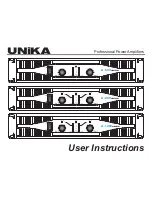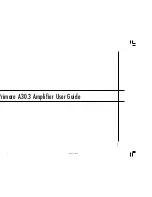
OPERATION
21
|
PreSonus 2008
2.4.3 Vocabulary of Dynamics Processors
In scientific research, it is widely accepted that if one needs to master a subject quickly, learn the associated
vocabulary and industry terms. The same is true with audio recording and production. Most manuals and
text books assume a prior level of knowledge. We hope this section will help you to get the most benefit from
your independent study in the world of music production.
Compressors
•
Threshold. The Compressor threshold sets the level at which compression begins. When the signal is
above the threshold setting, it becomes ‘eligible’ for compression. Basically, as you turn the
threshold knob counterclockwise, more of the input signal becomes compressed. (If you have a ratio
setting of greater than 1:1.)
•
Ratio. Ratio sets the compression slope. This is defined as the output level versus the input level.
For example, if you have the ratio set to 2:1, any signal levels above the threshold setting will be
compressed at a compression ratio of 2:1. This simply means that for every 1 dB of level increase
into the compressor, the output will only increase ½ dB, thus producing a compression gain
reduction of 0.5 dB per 1 dB. As you increase the ratio, the compressor gradually becomes a limiter.
A limiter is defined as a processor that limits the level of a signal to the setting of the threshold. For
example, if you have the threshold knob set at 0dB, and the ratio turned fully clockwise, the
compressor becomes a limiter at 0dB. This means that the signal will be limited to an output of 0dB
regardless of the level of the input signal.
•
Attack. Attack sets the speed at which the compressor ‘acts’ on the input signal. A slow attack time
(fully clockwise) allows the beginning envelope of a signal (commonly referred to as the initial
transient) to pass through the compressor uncompressed, whereas a fast attack time (fully counter-
clockwise) immediately subjects the signal to the ratio and threshold settings of the compressor.
•
Release. Release sets the length of time the compressor takes to return the gain reduction back to
zero (no gain reduction) after crossing below the compression threshold. Very short release times
can produce a very choppy or ‘jittery’ sound, especially in low frequency instruments such as a bass
guitar. Very long release times can result in an over compressed sound, sometimes referred to as
‘squashing’ the sound. All ranges of release can be useful at different times however and you should
experiment to become familiar with the different sound possibilities.
•
Hard/Soft Knee. With hard knee compression, the gain reduction applied to the signal occurs as
soon as the signal exceeds the level set by the threshold. With soft knee compression, the onset of
gain reduction occurs gradually after the signal has exceeded the threshold, producing a more
musical response (to some folks).
•
Auto. Places a compressor in automatic attack and release mode. The attack and release knobs
become inoperative and a pre-programmed attack and release curve is used.
•
Gain Makeup. When compressing a signal, gain reduction usually results in an overall reduction of
level. The gain control allows you to restore the loss in level due to compression. (Like readjusting
the volume.)
Summary of Contents for FIRESTUDIO TUBE
Page 4: ......















































